This post may contain affiliate links. Please read our disclosure policy.
These soft, homemade gluten free dinner rolls are easy enough for a weeknight—and special enough for any holiday table. They bake up golden, tender, and fluffy every time.

Why this recipe works
These dinner rolls bake up soft and fluffy inside with a beautiful golden brown crust outside that's still squishy, never tough. The dough comes together with just about 20 minutes of hands-on time and a fast rise, so you can have fresh rolls on the table quickly.
The dough itself is easy to handle and shape, making the process smooth from start to finish. Even if you’re new to baking bread, you’ll find this straight-forward recipe do-able, especially with our step by step photos below.
You can also parbake, or partially bake, them, and freeze, so you defrost and finish baking them right when you're ready. And if you’re avoiding dairy, simple ingredient swaps make it easy to keep these rolls completely dairy-free without losing their soft texture or buttery flavor.
Recipe ingredients

These few ingredients come together to make the softest, most tender gluten free rolls you’ve ever had:
- Gluten free flour – Use a high-quality all purpose gluten free flour blend made with finely ground rice flour. It should be designed for yeast baking. My favorite blends are Better Batter's original blend which already contains xanthan gum, and Nicole's Best with added xanthan gum. King Arthur Flour gluten free bread flour should also work (try adding 1 to 2 tablespoons extra milk), but avoid their multipurpose blends, which KAF itself says are not designed for yeast breads.
- Tapioca starch – Even though your blend almost certainly already includes this flour, this extra tapioca starch gives the dough stretch and flexibility.
- Instant yeast – Gives the rolls their rise. Also called rapid-rise or breadmaker yeast. Be sure yours is fresh.
- Sugar – Feeds the yeast and adds a subtle sweetness.
- Milk – Warm milk activates the yeast, moistens the dough, and adds richness.
- Butter – Adds moisture and flavor, keeping the rolls soft and tender.
- Egg whites – Provide structure, help bind the dough together, and help the rolls keep their shape as they cool.

How to make soft gluten free dinner rolls
The precise ingredient amounts are in the recipe card below, but here are step by step images so you know what to expect when you make them at home. Plus, explanations for each so you understand they “why,” not just the “how”:
Step 1: Mix the dry ingredients
In the bowl of a stand mixer, if possible, whisk together the gluten free flour, xanthan gum (if needed), tapioca starch, yeast, and sugar until well combined. Whisk in salt next. This is how we keep the salt from clumping with the yeast and creating an uneven rise.
Step 2: Add wet ingredients and beat the dough
Pour in the warm milk, melted butter, and egg whites. Using the paddle attachment, beat the mixture until it comes together and begins to look whipped (about 6 minutes total) to introduce air into the dough and help create fluffy rolls.
Step 3: First rise
Transfer the dough to a lightly oiled container with a tight-fitting lid. Let it rest at room temperature for about 2 hours, or refrigerate it for up to 24 hours to develop some yeasty flavor and allow the dough to absorb some of the liquid. If chilled, let the dough come back to room temperature before shaping or the cold butter in the dough may make it hard to shape without visible seams.




Step 4: Divide and shape
Turn the dough onto a very lightly floured surface and divide it in half, then each half into 8 equal pieces. Gently roll each piece into a ball by cupping your hand around the dough and moving it in a circular motion. This is the way to gently shape the dough into a round without compressing it and making the rolls dense.
Step 5: Arrange and rise again
Place the rolls into a greased and lined baking pan. You can crowd them slightly for pull-apart rolls or leave space for individual ones. Cover with plastic wrap and let them rise in a warm, draft-free spot until at least 150% of their original size (they won't double).




Step 6: Bake
Once risen, brush the tops with melted butter. Bake at 375°F until the rolls are golden and an instant-read thermometer reads around 190°F in the center—about 20 minutes. If the rolls are touching, reduce the oven temp to 350°F after 18 minutes and bake a bit longer, since keeping them close together means there's less room for the warm oven air to circulate.
Step 7: Serve warm
Brush the hot rolls with more melted butter for extra flavor, and serve while warm and soft.


Expert tips for perfect rolls
Use a stand mixer if you can
A stand mixer with the paddle attachment creates the smooth, whipped dough that gives these rolls their signature texture. If needed, a food processor with a plastic blade can work—just pulse carefully and don’t overmix. Avoid hand mixing.
Create a warm, steady rise
Place your dough in a draft-free spot with gentle warmth—like on top of a warm oven, never inside. If the environment is too hot, you risk killing the yeast. Too cool, and the dough will rise very, very slowly. Too dry, and it won't rise.
Adjust for dry climates
If you live in a dry environment and your dough isn’t rising well, try adding 1 extra tablespoon of warm milk or water. But don’t overdo it—too much liquid can cause overproofing and gummy rolls.
Shape gently
Don’t press or knead the dough aggressively. On a lightly floured surface, cup your hand around the dough ball and gently move it in a tight circle on a very lightly floured surface to create a smooth round shape.
Want to make them ahead? Try parbaking
To prep rolls in advance, bake the shaped rolls at 300°F for 15 minutes to 20 minutes—just until puffed and set but not browned. Cool completely, then freeze. They may sink a bit as they cool. When ready to serve, defrost at room temp, then finish baking at 375°F until golden and fully cooked (190°F inside). This method gives you fresh-baked rolls in less time.
Here's a video showing you how to parbake the rolls:

Easy ingredient swaps
Dairy free
Replace the melted butter with a block-style dairy-free butter alternative. Melt and Miyoko’s Kitchen brands both work well. For the milk, use an unsweetened nondairy variety with some fat and a texture that mimics cow's milk Avoid fat-free options, since richness matters here, and anything with unwanted texture, like oat milk.
Egg free
You should be able to replace the 2 egg whites with 50 grams of aquafaba (the liquid from a can of unsalted chickpeas).
Yeast
You can’t make these rolls without yeast, but you can swap instant yeast for active dry yeast. Use 15 grams of active dry yeast and be sure to proof it first in some of the warm milk.
Tapioca starch
Even though most good gluten free flour blends already include tapioca starch, this recipe needs extra. If you don’t have it, try replacing it with an equal amount of superfine glutinous rice flour or sweet white rice flour.

Storing & freezing the rolls
Best when fresh
Like all yeast rolls, these are at their best the day they’re baked. But you can still store and reheat them with great results.
Room temperature
Store leftover rolls in a sealed container at room temperature for up to 2 days. To refresh before serving, sprinkle lightly with lukewarm water and warm in a 300°F toaster oven for about 5 minutes.
Freezer storage
Once cooled, place baked and cooled rolls in a freezer-safe zip-top bag and press out as much air as possible. Freeze for up to 3 months. Defrost at room temperature and reheat as above. For parbaking instructions, see the Expert Tips section above.
FAQs
If your rolls didn’t rise, it’s usually a problem with the yeast, hydration, temperature, or timing. Here are the most common causes:
Expired yeast – Test it by mixing with warm water and sugar. If it doesn’t foam in 10 minutes, it’s no longer active. Store opened jars of yeast in the refrigerator.
Too much flour/too little moisture – Overmeasuring flour or starch can reduce hydration and stall rising. The same can happen if the dough rises improperly covered, and loses moisture.
Temperature issues – Milk that’s too hot can kill yeast.
Timing – You simply didn't let them rise long enough. Yeast will reproduce in cooler environments, but will just take longer. Overproofing happens when dough rises too much, not for too long.
No—you still need the additional tapioca starch listed in the recipe. All gluten free blends include some tapioca, but this recipe relies on a larger amount to give the dough its flexibility and the rolls their soft, stretchy texture.
No—this dough won’t hold its shape that long after shaping. It’s best to refrigerate the dough before shaping, then bring it to room temperature and shape right before the second rise.
Not recommended—it's best to bake and freeze the rolls, or use the parbake method above.
Yes, but they won’t have the same pull-apart quality. Bake time may be slightly shorter.
Yes—just cut all ingredients in half. I do this all the time! Rise and bake times stay the same.
Gluten Free Dinner Rolls Recipe

Ingredients
- 3 ¼ cups (455 g) all purpose gluten free flour blend, (See Recipe Notes)
- 3 ¼ teaspoons xanthan gum, omit if your blend already contains it
- ⅞ cup (105 g) tapioca starch/flour, plus more for sprinkling
- 4 teaspoons (12 g) instant yeast, See Recipe Notes
- ¼ cup (50 g) granulated sugar
- 1 teaspoon kosher salt
- 1 ⅝ cup (13 fluid ounces) warm milk (about 90°F)
- 8 tablespoons (112 g) unsalted butter, melted and cooled (plus more for brushing)
- 2 (50 g) egg whites, at room temperature
Instructions
Make the dough
- In the bowl of a stand mixer (See Recipe Notes), place the flour, xanthan gum, tapioca starch/flour, instant yeast, and granulated sugar, and whisk to combine well. Add the salt, and whisk again to combine.
- Add the milk, melted butter, and egg whites. Using the paddle attachment, beat vigorously. The mixture will come together in a clump and clear the sides of the bowl. Keep beating until it begins to look whipped, and sticks to the side of the mixing bowl again (about 6 minutes total).
- Transfer the mixture to a lightly oiled bucket or bowl with a very tight-fitting lid. The container should be large enough for the dough to nearly double (although it won’t double fully).
Chill the dough
- Refrigerate the dough for at least 30 minutes and up to 3 days in the refrigerator. Do not let the dough rest/rise for too long, or your rolls will rise much more irregularly after shaping.
- If your dough has been refrigerated for more than 1 hour, allow it to sit at room temperature until no longer very cold to the touch before working with it.
Shape the rolls
- Grease a quarter sheet pan or 2 8-inch round cake pans for baking, and set them aside. You will later decide if you’d like to crowd the rolls, and have them rise then bake touching, or have them separate.
- Flour a clean, dry work surface very lightly with tapioca starch. Divide the dough in half, then each half into 8 equal portions, for 16 pieces, each about 2 1/2 ounces in weight.
- Working with one piece of dough at a time, cup your fingers around the dough, keep the side of your palm on the surface, and move your hand in tight circles to coax the dough into a round.
- Place the shaped rounds of dough in your chosen baking pan(s) either touching (they will rise mostly up), or a bit more than 1-inch apart, taking care not to crowd them (the will rise up and out).
Let rise
- Cover the pan(s) with lightly greased plastic wrap, place in a warm, draft-free location, and allow to rise until about 150% of their original size (they won't quite double).
- This rise can take anywhere from 45 minutes to hours, depending upon the ambient temperature in your kitchen. Overproofing is not very likely, and can be detected when the surface of the rolls begins to look pockmarked.
- When the rolls are nearing the end of their rise, preheat your oven to 375°F. Once the rolls are properly risen, remove the plastic wrap from the pan(s), and brush generously on all exposed sides with melted butter.
Bake
- Bake until an instant read thermometer inserted into the center of each roll reads about 190°F.
- If there is any space between the rolls after they’ve risen, they will take around 20 minutes until fully baked.
- If the rolls are touching one another, lower the oven temperature to about 350°F at 18 minutes and continue to bake for about another 5 minutes or until the center reaches 190°F.
- Remove the pan from the oven, and with the rolls still in the hot pan, brush again with melted butter and serve warm.
Video
Notes
I recommend Better Batter’s original blend or my Nicole’s Best multipurpose blend (with 3 teaspoons added xanthan gum). King Arthur's gluten free bread flour can work but makes denser rolls, so consider adding 2 tablespoons more milk. Avoid Cup4Cup and Measure for Measure here—they won't produce the right texture. Bob’s Red Mill 1-to-1 isn't ideal, but in a pinch, it may work if you add at least 1½ teaspoons extra xanthan gum. You'll have to watch the dough in your mixer and add more xanthan gum very slowly if it doesn't appear to be thick enough as compared to my photos and video. To make your own blend using one of my “mock” recipes, please see the all purpose gluten free flour blends page. Using active dry yeast:
You can swap instant yeast for active dry yeast—just use 15 grams instead of 12 and proof it in some of the warm milk before adding. No stand mixer?
A food processor with the plastic blade works in a pinch. Don’t use a hand mixer or mix by hand; the dough needs vigorous mixing to whip up properly and create a smooth shaped roll.
Nutrition
Nutrition information is automatically calculated, so should only be used as an approximation.
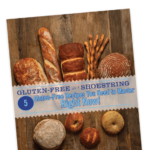

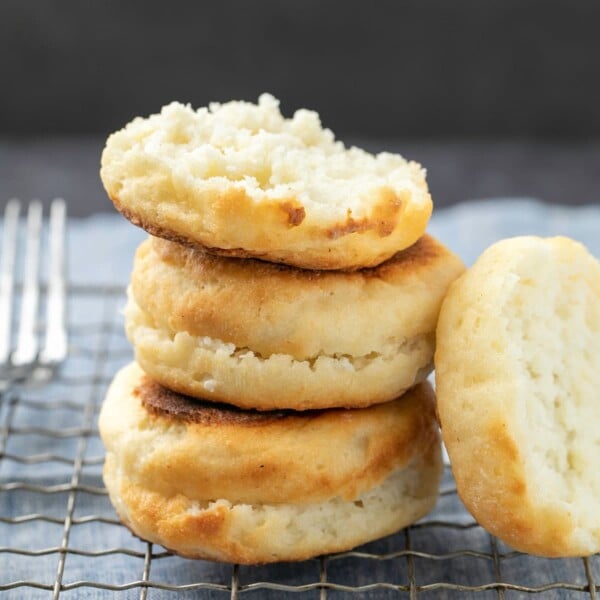

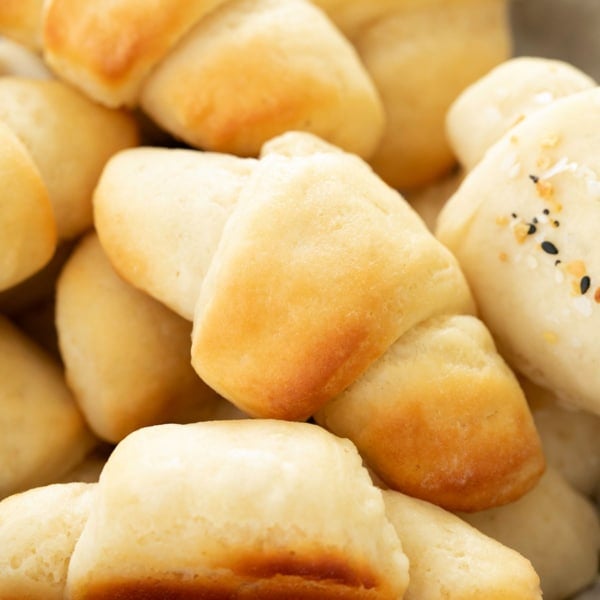

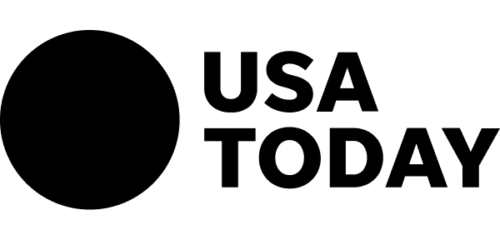

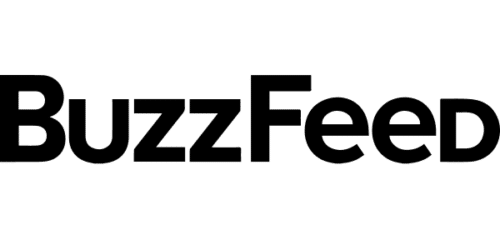
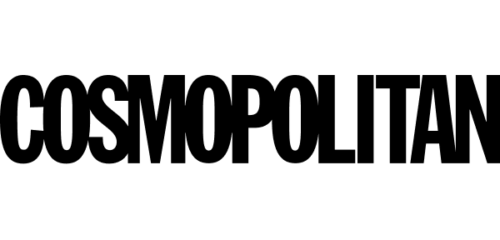
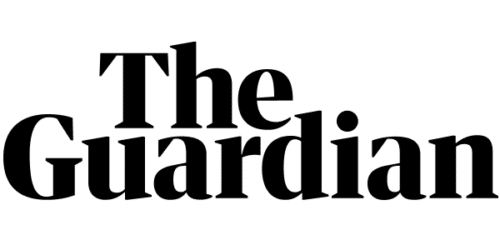




Could this potentially become a honey butter roll. My sister is gluten free and i’ve tried numerous recipes and every time that I bake rolls, they do not come out right?But I make perfect, honey butter parker house rolls literally amazing, and i’ve tried everything to make gluten free.Ones and nothing comes out right?Do you have any suggestions??
You can try brushing them before they go in the oven and after with a mixture of melted butter and honey, sure, Kayla. I’m afraid I can’t speak to why others’ recipes aren’t turning out for you, but I will caution you (as stated in the recipe and post) that you must be careful to select one of my recommended all purpose gluten free flour blends, and measure by weight for the promised results. If what you’ve been doing is using a conventional gluten-containing recipe and using a gluten free flour, that will never ever work.
Wld this recipe work for cinnamon rolls? Wld it hold shape? Cld i shape after first rise and refrigerate overnight, then do second rise?
I don’t recommend that, Margaret, but I have a recipe for truly amazing gluten free cinnamon rolls that I think you’d love instead.
Mine did not brown. At all. They looked like pale matzah balls, that’s how pale they were. But they tasted really good! (It’s been so long since I’ve had a yeasty roll!) I’m sure the blobfishy outcome was something I did or my dumb oven (but internal temp was spot on when I took them out), so I’ll try again another time!
But again, so authentically yeasty and delish! Truly, that’s all that matters to me. I just need a nice vehicle for butter… :)
Hi, Allie, if your oven runs hot, which most ovens do, they can bake too quickly before they have a chance to brown. I’d also take a look at your flour blend, as some don’t brown well because they’re not fully balanced. Brushing with melted butter should help with browning, so definitely don’t skip that step! Thank you for sharing your experience.
It took me three tries to get these right but the third batch was a win. The key for me was adjusting the rise time. I know it is very subjective. But I left them in the fridge to rise for 14 hours and that was perfect. Any less just wasn’t enough so be patient with that part. Everyone – even nonGF diners – loved them. I will make these again when the need arises.
Can I modify the recipe for dairy free?
Please see the text of the post under the heading “Ingredient substitutions” for my suggestions, Tammy.
I have made these twice using Better Batter and following your directions to the tee. Both times I’ve gotten a much denser bread than yours appear to be. Did I not leave them in the fridge for the first rise long enough (I guessed at “nearly double”)? I was able to pick up the balls and roll them in my hands. Please advise as the flavor is excellent.
Did you measure your ingredients by weight, NLA? Did you make ingredient substitutions (everyone says they “followed the recipe to a tee” but rarely does anyone actually, as human nature is to deviate in ways you don’t think matter but often do)? Were your ingredients at room temperature as specified? Did you use a stand mixer and beat the dough sufficiently? There are many variables and ways to deviate. You also perhaps simply didn’t let the rolls rise enough. Rising times are always approximate and are very environment-dependent.
Hi! I did measure by weight, I made no substitutions, room temp yes, milk at 90 degrees, stand mixer used (first batch beat for suggested 6 minutes even though the dough stuck back to sides after less than 3). Which was a question: second time I stopped at under 3 minutes because the dough stuck to walls and I thought maybe I had over-beaten the first batch. Which is more important: time of beating or sticking to the walls? And perhaps I didn’t let them rise long enough in the fridge – but it appeared nearly doubled. I am sure the environment is a huge factor (humid southeast here) but I sure would love to get these right as the flavor is well worth it. Thank you for being so responsive!!
It sounds like you just didn’t let them rise enough after shaping, NLA. Everything else seems to be in order. The first rise is for flavor development and to let the flour absorb the liquid, which makes the dough easier to handle. Be sure to watch the videos in this post so you see that you really don’t add much flour during shaping, which will lower hydration and inhibit rise.
First time trying these. Confused by the step to put in a bowl with tight lid. The next step then goes into chilling the dough. But assume the dough needs to rise/double in size in the bowl then chill in refrigerator and then roll into bowls and let rise again?
Sheryl, gluten free yeast bread dough is not the same as conventional yeast bread. There’s no error in the recipe. You let the unshaped dough rise in the lidded bucket or covered bowl, then shape, rise and bake.
This is the second time recently I’ve made one of your bread bread recipes and the surface has been craggy and not wanted to smooth. I’m wondering if the issue is my mixing time or speed or if my dough isn’t hydrating properly for some reason. Thoughts?
Hi, Lindsay, it may just be the way you’re shaping it. Unlike with conventional bread, there’s no gluten to activate enough to create enough surface tension to make a traditionally taut surface. You need to pinch any seams as you go, and shape with the side of your hand. Please watch the new YouTube video I shared on this page about parbaking rolls for some more visuals. There are also all the usual suspects of the flour blend you chose, how you measured (if by volume, it’s just not accurate), did you make ingredient substitutions, etc.).
Hi,
I have attempted making these rolls twice. And both times they have come out gummy with a harder outside shell and do not brown. I have an oven thermometer to make sure the temperature is correct, and I measure out all my ingredients. I do use Nicole‘s multipurpose gluten-free flower blend. I used active yeast 15 g, and proofed the yeast in milk. Not sure what I am doing wrong. Thank you!
Hi, Jan, did you let the rolls rise until they were at least 50% larger than when they began? Did you measure your ingredients by weight? It sounds you are working with a dough with too little hydration, which comes from overmeasuring dry ingredients and/or working too much flour into the raw dough during shaping, both of which will inhibit rise and lead to dense rolls.
Alot of gluten free breads and rolls have the addition of about 1 tsp apple cider vinegar which add a nice flavor to baked goods. Could I remove 1 tsp of the milk and replace it with the apple cider vinegar or would it cause the recipe not to work?
Many of my recipes for gluten free bread do call for apple cider vinegar, but I don’t like it in this one, as these are highly enriched rolls that already call for a cold, first rise which allows for some flavor development. I also find that they don’t need the rising assistance, and benefit from a more controlled, lower rise.